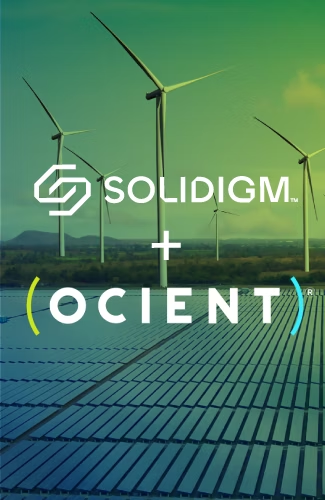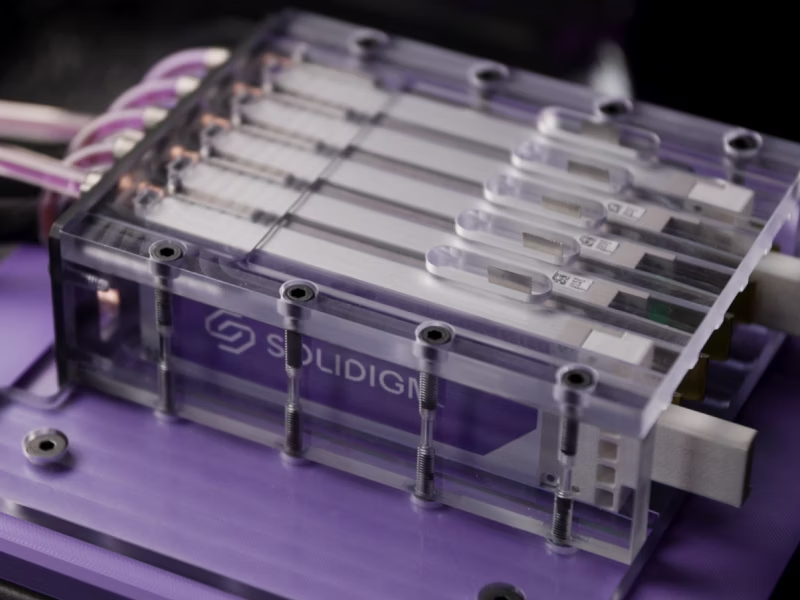Ocient: Energy Efficiency at Scale
How Solidigm SSDs enable Ocient to reduce the cost, system footprint, and energy consumption of compute-intensive data and AI workloads by up to 90%


In 2024, the world created, captured, copied, and consumed 149 zettabytes (ZB) of data—and that amount is projected to grow. IDC calculates that 163,006 exabytes (EB) of data was generated in 2024 and will more than double to 393,852EB generated in 2028, representing a CAGR of 24.4% over the forecast period, as published in IDC’s Global DataSphere, 2024.
In this environment, enterprises face mounting pressure to process massive amounts of data while managing costs, space, and energy consumption. Compute-intensive workloads and AI-driven applications demand new levels of efficiency, both in terms of hardware and software architecture.
Ocient’s platform has already saved $1.6 million for a cornerstone customer in energy costs over three years, alongside reductions in hardware, CapEx, and OpEx.
Ocient, a pioneer in data analytics software solutions, is redefining efficiency for always-on, compute-intensive data and AI workloads. The company’s efficient, unified platform—optimized to run on modern, industry-standard hardware—leverages the Solidigm advanced solid-state drive (SSD) storage technology to reduce cost, energy consumption, and system footprint of data analytics workloads up to 90%, further enabling customers to achieve sustainable data performance and management at scale.1
The challenge: Scaling while managing resources
Enterprises running compute-intensive workloads are grappling with how to scale their data operations to meet increasing demand without dramatically increasing operational costs or environmental impact. The Ocient Hyperscale Data Warehouse, built specifically to solve these challenges, leverages a completely reimagined design to deliver real-time analysis for always-on workloads at scale. Its innovative architecture minimizes the hardware footprint while delivering exceptional performance enabling customers to ingest data and extract insights faster, even with always-on, petabyte-scale datasets.
The Role of Solidigm SSDs
16TB-class SSDs from Solidigm are the underlying storage for Ocient’s innovative architecture. The Solidigm™ D7-P5520 SSD and Solidigm™ D5-P5430 SSD play a critical role in optimizing storage density, power efficiency, and system level performance. Solidigm SSDs deliver exceptional storage density, enabling customers to scale up to store 1.2 petabytes (PB) of data in a single 2U server. With fewer drives required to meet capacity and performance goals, Ocient solutions on Solidigm storage enable customers to minimize the footprint of their workloads in the data center. This is particularly critical for large data environments, where real estate and hardware costs can grow rapidly.
Solidigm SSDs deliver industry-leading power efficiency, unlike hard-disk drives (HDDs) with spinning-disk technology. Solidigm NAND-based SSDs provide more than 400% higher performance per watt on a typical sequential write workload and more than 27,000% higher perf/watt with mixed random workloads.2 This makes Solidigm SSDs a cornerstone of Ocient’s ability to provide operational efficiency and reduce energy consumption at scale.
Ocient’s unique Compute Adjacent Storage Architecture (CASA) ensures SSDs connect directly to processors via a fast PCIe 4.0 bus, unleashing hundreds of millions of parallel tasks and eliminating data access bottlenecks. By combining Solidigm high-speed SSDs with its CASA architecture, Ocient achieves over 1.2 terabits per second of data scanning performance, enabling faster queries and analytics.
Delivering tangible results: Empowering customers to do more with less
Ocient’s platform has already saved $1.6 million for a cornerstone customer in energy costs over three years, alongside reductions in hardware, CapEx, and OpEx. These savings highlight the potential for combining innovative storage technologies with highly optimized software. The legacy infrastructure included a data center footprint that was consuming a massive amount of power at 202 kW. This legacy system had 10 racks averaging 145 kW of power that was running a workload on Hadoop and Apache Spark as a data warehouse and requiring 4.41PB of storage. After migrating to Ocient, the customer significantly reduced its footprint from 10 racks to three racks. This subsequent reduction lowered the power from a maximum of 202 kW to 46 kW, drastically increasing massive energy cost savings over three years and accelerating ROI. Query times also decreased, reducing from minutes to seconds.
 Figure 1. Tier 1 telecommunications provider transitioned from legacy HDD infrastructure to Solidigm SSDs with Ocient platform.
Figure 1. Tier 1 telecommunications provider transitioned from legacy HDD infrastructure to Solidigm SSDs with Ocient platform.
Another example (above) is a tier 1 telecommunications provider, which needed to transition off a different legacy infrastructure, a system which relied on five full racks with HDDs and consumed over 115 kW of power to manage over 17PB of CDR (call detail records) data. Challenges began when certain queries were unable to be completed, and the company decided they needed a more modern solution. After migrating to Solidigm SSDs with the Ocient platform, the customer’s workload was consolidated into a single rack requiring only 22 kW of power. This transformation reduced upfront CapEx on hardware and OpEx on energy costs allowing the customer to reinvest much needed resources into innovation and growth.
Efficiency built into every layer
Ocient’s efficiency gains extend beyond hardware to software innovations that maximize the potential of Solidigm SSDs. The company’s TimeKey clustering organizes data by time and user-defined keys, allowing minimal data to be read from storage for each query. This efficiency ensures maximum throughput leveraging the performance of Solidigm SSDs to deliver lightning-fast analytics.
In addition, Ocient’s Zero Copy Reliability eliminates the need for data replication, reducing storage requirements by up to 90%.1 Combined with the reliability of Solidigm SSDs, this innovation allows customers to store and query data more confidently while maintaining data integrity.
Ocient also utilizes advanced compression techniques and parallel processing capabilities to ensure high performance even for the largest workloads. With Solidigm SSDs providing the bandwidth to match, customers achieve fast, scalable results with fewer resources.
Dedication to power efficiency
In a time when data center energy consumption is under scrutiny, Ocient and Solidigm are committed to delivering more efficient and sustainable solutions. The power-efficiency of Solidigm SSDs help data centers reduce legacy carbon footprints, and improve costs, and Ocient’s efficient software solutions reduce the hardware architecture and net energy required for compute-intensive data and AI workloads.
Scaling with confidence
The collaboration between Ocient and Solidigm demonstrates the power of hardware-software co-design for delivering solutions that solve customer needs by enabling performance, cost-effectiveness, and efficient, explosive data growth. By enabling up to 90% reduction in system level cost, space, and energy consumption, Ocient and Solidigm showcase the transformative potential of combining innovative storage technologies with purpose-built software solutions. Together, they help empower customers to do more with less.
1Source: Ocient: https://ocient.com/blog/ocient-and-solidigm-help-reduce-energy-hungry-ai-data-pipelines/
2Claim: comparing WD HC580 24TB SATA HDD to Solidigm D5-P5430 30.72TB SSD using 100% 128KB QD 256 seq. write WL and 70/30 R/W random 4KB QD512 WL
Nothing herein is intended to create any express or implied warranty, including without limitation, the implied warranties of merchantability, fitness for a particular purpose, and non-infringement, or any warranty arising from course of performance, course of dealing, or usage in trade.
The products described in this document may contain design defects or errors known as “errata,” which may cause the product to deviate from published specifications. Current characterized errata are available on request.
Solidigm does not control or audit third-party data. You should consult other sources to evaluate accuracy.
Contact your Solidigm representative or your distributor to obtain the latest specifications before placing your product order.
SOLIDIGM and the Solidigm “S” logo are trademarks of SK hynix NAND Product Solutions Corp. (d/b/a Solidigm), registered in the United States, People’s Republic of China, Japan, Singapore, the European Union, the United Kingdom, Mexico, and other countries.





